Accuracy Evaluation of Two High-Resolution Satellite-Based Rainfall Products: TRMM 3B42V7 and CMORPH in Shanghai
Abstract
:1. Introduction
2. Materials and Methods
2.1. Study Area
2.2. Dataset
2.2.1. Satellite-Based Rainfall Products
2.2.2. Rain Gauge Data
2.3. Evaluation Methods
3. Results
3.1. Detection Capability Analysis on Rainfall Events
3.2. Error Statistics Analysis
4. Discussion
4.1. The Error Distribution Characteristics of 3B42V7 and CMORPH
4.2. Extreme Rainfall Evaluation of 3B42V7 and CMORPH
5. Conclusions
Acknowledgments
Author Contributions
Conflicts of Interest
References
- Romps, D.M. Response of Tropical Precipitation to Global Warming. J. Atmos. Sci. 2010, 68, 123–138. [Google Scholar] [CrossRef]
- James, R.; Washington, R. Changes in African temperature and precipitation associated with degrees of global warming. Clim. Chang. 2013, 117, 859–872. [Google Scholar] [CrossRef]
- Karmalkar, A.V.; Bradley, R.S. Consequences of Global Warming of 1.5 °C and 2 °C for Regional Temperature and Precipitation Changes in the Contiguous United States. PLoS ONE 2017, 12, e0168697. [Google Scholar] [CrossRef] [PubMed]
- Huang, P. Regional response of annual-mean tropical rainfall to global warming. Atmos. Sci. Lett. 2014, 15, 103–109. [Google Scholar] [CrossRef]
- Intergovernmental Panel on Climate Change. Climate Change 2013: The Physical Science Basis. Contribution of Working Group I to the Fifth Assessment Report of the Intergovernmental Panel on Climate Change; Cambridge University Press: New York, NY, USA, 2013. [Google Scholar]
- Zhai, P.M.; Zhang, X.B.; Wan, H.; Pan, X. Trends in Total Precipitation and Frequency of Daily Precipitation Extremes over China. J. Clim. 2005, 18, 1096–1108. [Google Scholar] [CrossRef]
- Shrestha, A.B.; Bajracharya, S.R.; Sharma, A.R.; Duo, C.; Kulkarni, A. Observed trends and changes in daily temperature and precipitation extremes over the Koshi river basin 1975–2010. Int. J. Climatol. 2017, 37, 1066–1083. [Google Scholar] [CrossRef]
- Jones, M.R.; Blenkinsop, S.; Fowler, H.J.; Kilsby, C.G. Objective classification of extreme rainfall regions for the UK and updated estimates of trends in regional extreme rainfall. Int. J. Climatol. 2014, 34, 751–765. [Google Scholar] [CrossRef]
- Han, W.S.; Burian, S.J.; Shepherd, J.M. Assessment of satellite-based rainfall estimates in urban areas in different geographic and climatic regions. Nat. Hazards 2011, 56, 733–747. [Google Scholar] [CrossRef]
- Rajeevan, M.; Bhate, J.; Jaswal, A.K. Analysis of variability and trends of extreme rainfall events over India using 104 years of gridded daily rainfall data. Geophys. Res. Lett. 2008, 35, 60–74. [Google Scholar]
- Huffman, G.A.; Adler, R.; Bolvin, D.T.; Gu, G.; Nelkin, E.; Bowman, K.; Hong, Y.; Stocker, T.; Wolff, D. The TRMM multi-satellite precipitation analysis (TMPA): Quasi-global, multiyear, combined-sensor precipitation estimates at fine scale. J. Hydrometeorol. 2007, 8, 38–55. [Google Scholar] [CrossRef]
- Joyce, R.J.; Janowiak, J.E.; Arkin, P.A.; Xie, P.P. CMORPH: A Method That Produces Global Precipitation Estimates From Passive Microwave and Infrared Data at High Spatial and Temporal Resolution. J. Hydrometeorol. 2004, 5, 287–296. [Google Scholar] [CrossRef]
- Sorooshian, S.; Hsu, K.-L.; Gao, X.G.; Gupta, H.V.; Imam, B.; Braithwaite, D. Evaluation of PERSIANN System Satellite–Based Estimates of Tropical Rainfall. Bull. Am. Meteorol. Soc. 2000, 81, 2035–2046. [Google Scholar] [CrossRef]
- Tang, B.H.; Bi, Y.Y.; Li, Z.L.; Xia, J. Generalized Split-Window Algorithm for Estimate of Land Surface Temperature from Chinese Geostationary FengYun Meteorological Satellite (FY-2C) Data. Sensors 2008, 8, 933–951. [Google Scholar] [CrossRef] [PubMed]
- Liu, J.Z.; Duan, Z.; Jiang, J.C.; Zhu, A.X. Evaluation of three satellite precipitation products TRMM 3B42, CMORPH, and PERSIANN over a subtropical watershed in China. Adv. Meteorol. 2015, 2015, 2731–2738. [Google Scholar] [CrossRef]
- Tang, L.; Tian, Y.D.; Yan, F.; Habib, E. An improved procedure for the validation of satellite-based precipitation estimates. Atmos. Res. 2015, 163, 61–73. [Google Scholar] [CrossRef]
- Vernimmen, R.R.E.; Hooijer, A.; Mamenun; Aldrian, E.; van Dijk, A.I.J.M. Evaluation and bias correction of satellite rainfall data for drought monitoring in Indonesia. Hydrol. Earth Syst. Sci. 2012, 8, 5969–5997. [Google Scholar] [CrossRef]
- Hong, Y.; Adler, R.F.; Negri, A.; Huffman, G.J. Flood and landslide applications of near real-time satellite rainfall products. Nat. Hazards 2007, 43, 285–294. [Google Scholar] [CrossRef]
- Hong, Y.; Adler, R.F. Predicting global landslide spatiotemporal distribution: Integrating landslide susceptibility zoning techniques and real-time satellite rainfall estimates. Int. J. Sediment Res. 2008, 23, 249–257. [Google Scholar] [CrossRef]
- Li, W.Y.; Liu, C.; Hong, Y.; Saharia, M.; Sun, W.W.; Yao, D.J.; Chen, W. Rainstorm-induced shallow landslides process and evaluation—A case study from three hot spots, China. Geomat. Nat. Hazards Risk 2016, 7, 1–11. [Google Scholar] [CrossRef]
- Jiang, S.H.; Ren, L.L.; Hong, Y.; Yang, X.L.; Ma, M.W.; Zhang, Y.; Yuan, F. Improvement of Multi-Satellite Real-Time Precipitation Products for Ensemble Streamflow Simulation in a Middle Latitude Basin in South China. Water Resour. Manag. 2014, 28, 2259–2278. [Google Scholar] [CrossRef]
- Lee, H.; Zhang, Y.; Seo, D.J.; Xie, P.P. Utilizing satellite precipitation estimates for streamflow forecasting via adjustment of mean field bias in precipitation data and assimilation of streamflow observations. J. Hydrol. 2015, 529, 779–794. [Google Scholar] [CrossRef]
- Zhu, Q.; Xuan, W.; Liu, L.; Xu, Y.-P. Evaluation and hydrological application of precipitation estimates derived from PERSIANN-CDR, TRMM 3B42V7, and NCEP-CFSR over humid regions in China. Hydrol. Process. 2016, 30, 3061–3083. [Google Scholar] [CrossRef]
- Jiang, S.H.; Liu, S.Y.; Ren, L.L.; Yong, B.; Zhang, L.Q.; Wang, M.H.; Lu, Y.J.; He, Y.Q. Hydrologic Evaluation of Six High Resolution Satellite Precipitation Products in Capturing Extreme Precipitation and Streamflow over a Medium-Sized Basin in China. Water 2018, 10, 25. [Google Scholar] [CrossRef]
- Zhang, Y.; Smith, J.A.; Luo, L.F.; Wang, Z.F.; Baeck, M.L. Urbanization and Rainfall Variability in the Beijing Metropolitan Region. J. Hydrometeorol. 2014, 15, 2219–2235. [Google Scholar] [CrossRef]
- Chen, S.; Li, W.-B.; Du, Y.-D.; Mao, C.-Y.; Zhang, L. Urbanization effect on precipitation over the Pearl River Delta based on CMORPH data. Adv. Clim. Chang. Res. 2015, 6, 16–22. [Google Scholar] [CrossRef]
- Meng, D.; Gong, H.L.; Li, X.J.; Yang, S.Y. Spatiotemporal distribution of the rainstorm and the relationship between urban heat island and urban rain island in Beijing on July 21, 2012. Remote Sens. Land Resour. 2017, 29, 178–185. [Google Scholar]
- Seino, N.; Aoyagi, T.; Tsuguti, H. Numerical simulation of urban impact on precipitation in Tokyo: How does urban temperature rise affect precipitation? Urban Clim. 2016, in press. [Google Scholar] [CrossRef]
- Wang, D.G.; Jiang, P.; Wang, G.L.; Wang, D.S. Urban extent enhances extreme precipitation over the Pearl River Delta, China. Atmos. Sci. Lett. 2015, 16, 310–317. [Google Scholar] [CrossRef]
- Liang, P.; Ding, Y.H. The long-term variation of extreme heavy precipitation and its link to urbanization effects in Shanghai during 1916–2014. Adv. Atmos. Sci. 2017, 34, 321–334. [Google Scholar] [CrossRef]
- Li, D.; Christakos, G.; Ding, X.X.; Wu, J.P. Adequacy of TRMM satellite rainfall data in driving the SWAT modelling of Tiaoxi catchment (Taihu lake basin, China). J. Hydrol. 2018, 556, 1139–1152. [Google Scholar] [CrossRef]
- Christian, K.; William, B.; Toshiaki, K.; James, S.; Joanne, S. The Tropical Rainfall Measuring Mission (TRMM) Sensor Package. J. Atmos. Ocean. Technol. 1998, 15, 809–817. [Google Scholar]
- Hong, Y.; Kummerow, C.D.; Olson, W.S. Separation of Convective and Stratiform Precipitation Using Microwave Brightness Temperature. J. Appl. Meteorol. 1999, 38, 1195–1213. [Google Scholar] [CrossRef]
- Huang, Y.; Chen, S.; Cao, Q.; Hong, Y.; Wu, B.W.; Huang, M.Y.; Qiao, L.; Zhang, Z.X.; Li, Z.; Li, W.Y.; et al. Evaluation of Version-7 TRMM Multi-Satellite Precipitation Analysis Product during the Beijing Extreme Heavy Rainfall Event of 21 July 2012. Water 2013, 6, 32–44. [Google Scholar] [CrossRef]
- Kim, K.Y.; Park, J.M.; Baik, J.J.; Choi, M.H. Evaluation of topographical and seasonal feature using GPM IMERG and TRMM 3B42 over Far-East Asia. Atmos. Res. 2017, 187, 95–105. [Google Scholar] [CrossRef]
- Shen, Y.; Xiong, A.Y.; Wang, Y.; Xie, P.P. Performance of high-resolution satellite precipitation products over China. J. Geophys. Res. 2010, 115, D02114. [Google Scholar] [CrossRef]
- Duan, Z.; Liu, J.Z.; Tuo, Y.; Chiogna, G.; Disse, M. Evaluation of eight high spatial resolution gridded precipitation products in Adige Basin (Italy) at multiple temporal and spatial scales. Sci. Total Environ. 2016, 573, 1536–1553. [Google Scholar] [CrossRef] [PubMed]
- Dinku, T.; Ceccato, P.; Grover-Kopec, E.; Lemma, M.; Connor, S.J.; Ropelewski, C.F. Validation of satellite rainfall products over East Africa’s complex topography. Int. J. Remote Sens. 2007, 28, 1503–1526. [Google Scholar] [CrossRef]
- Tan, M.L.; Santo, H. Comparison of GPM IMERG, TMPA 3B42 and PERSIANN-CDR satellite precipitation products over Malaysia. Atmos. Res. 2018, 202, 63–76. [Google Scholar] [CrossRef]
- Wu, C.L.; Chau, K.W.; Fan, C. Prediction of rainfall time series using modular artificial neural networks coupled with data-preprocessing techniques. J. Hydrol. 2010, 389, 146–167. [Google Scholar] [CrossRef]
- Sapiano, M.R.P.; Arkin, P.A. An intercomparison and validation of high-resolution satellite precipitation estimates with 3-hourly gauge data. J. Hydrometeorol. 2009, 10, 149–166. [Google Scholar] [CrossRef]
- Prakash, S.; Mitra, A.K.; AghaKouchak, A.; Pai, D.S. Error characterization of TRMM Multisatellite Precipitation Analysis (TMPA-3B42) products over India for different seasons. J. Hydrol. 2015, 529, 1302–1312. [Google Scholar] [CrossRef]
- Xu, R.; Tian, F.Q.; Yang, L.; Hu, H.C.; Lu, H.; Hou, A.Z. Ground validation of GPM IMERG and TRMM 3B42V7 rainfall products over southern Tibetan Plateau based on a high-density rain gauge network. J. Geophys. Res. Atmos. 2017, 122, 910–924. [Google Scholar] [CrossRef]
- Zhang, A.; Li, S.C.; Zhao, X.Y. Rainstorm risk assessment of Beijing-Tianjing-Hebei region based on TRMM data. J. Nat. Disasters 2017, 26, 160–168. [Google Scholar]
- Tan, M.; Duan, Z. Assessment of GPM and TRMM Precipitation Products over Singapore. Remote Sens. 2017, 9, 720. [Google Scholar] [CrossRef]
- Demaria, E.M.C.; Nijssen, B.; Valdés, J.B.; Rodriguez, D.A.; Su, F. Satellite precipitation in southeastern South America: How do sampling errors impact high flow simulations? Int. J. River Basin Manag. 2014, 12, 1–13. [Google Scholar] [CrossRef]
- Steiner, M.; Bell, T.L.; Zhang, Y.; Wood, E.F. Comparison of two methods for estimating the sampling-related uncertainty of satellite rainfall averages based on a large radar dataset. J. Clim. 2003, 16, 3759–3778. [Google Scholar] [CrossRef]
- Furuzawa, F.A.; Nakamura, K. Differences of Rainfall Estimates over Land by Tropical Rainfall Measuring Mission (TRMM) Precipitation Radar (PR) and TRMM Microwave Imager (TMI)-Dependence on Storm Height. J. Appl. Meteorol. 2005, 44, 367–383. [Google Scholar] [CrossRef]
- Huang, Y. Temporal changes in the patterns of extreme air temperature and precipitation in the various regions of China in recent 50 years. Acta Meteorol. Sin. 2011, 69, 125–136. [Google Scholar]
- Chen, Y.; Zhai, P.M. Persistent extreme precipitation events in China during 1951–2010. Clim. Res. 2013, 57, 143–155. [Google Scholar] [CrossRef]
- Gholami, V.; Chau, K.W.; Fadaee, F.; Torkaman, J.; Ghaffari, A. Modeling of groundwater level fluctuations using dendrochronology in alluvial aquifers. J. Hydrol. 2015, 529, 1060–1069. [Google Scholar] [CrossRef]
- Chen, X.Y.; Chau, K.W.; Busari, A.O. A comparative study of population-based optimization algorithms for downstream river flow forecasting by a hybrid neural network model. Eng. Appl. Artif. Intell. 2015, 46, 258–268. [Google Scholar] [CrossRef]
- Taormina, R.; Chau, K.W.; Sivakumar, B. Neural network river forecasting through baseflow separation and binary-coded swarm optimization. J. Hydrol. 2015, 529, 1788–1797. [Google Scholar] [CrossRef]
- Wang, W.C.; Chau, K.W.; Xu, D.M.; Qiu, L.; Liu, C.C. The Annual Maximum Flood Peak Discharge Forecasting Using Hermite Projection Pursuit Regression with SSO and LS Method. Water Resour. Manag. 2017, 31, 461–477. [Google Scholar] [CrossRef]
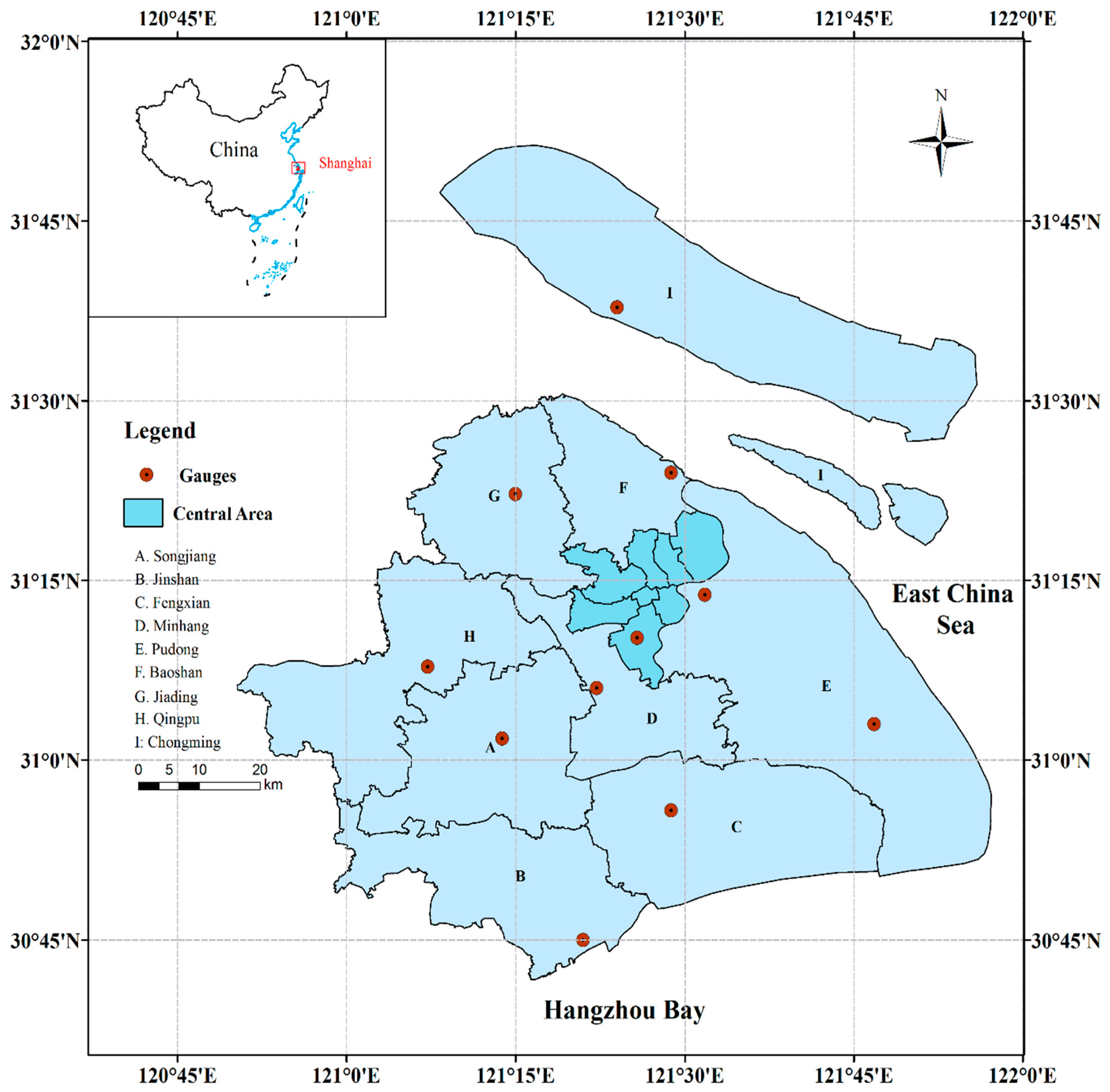

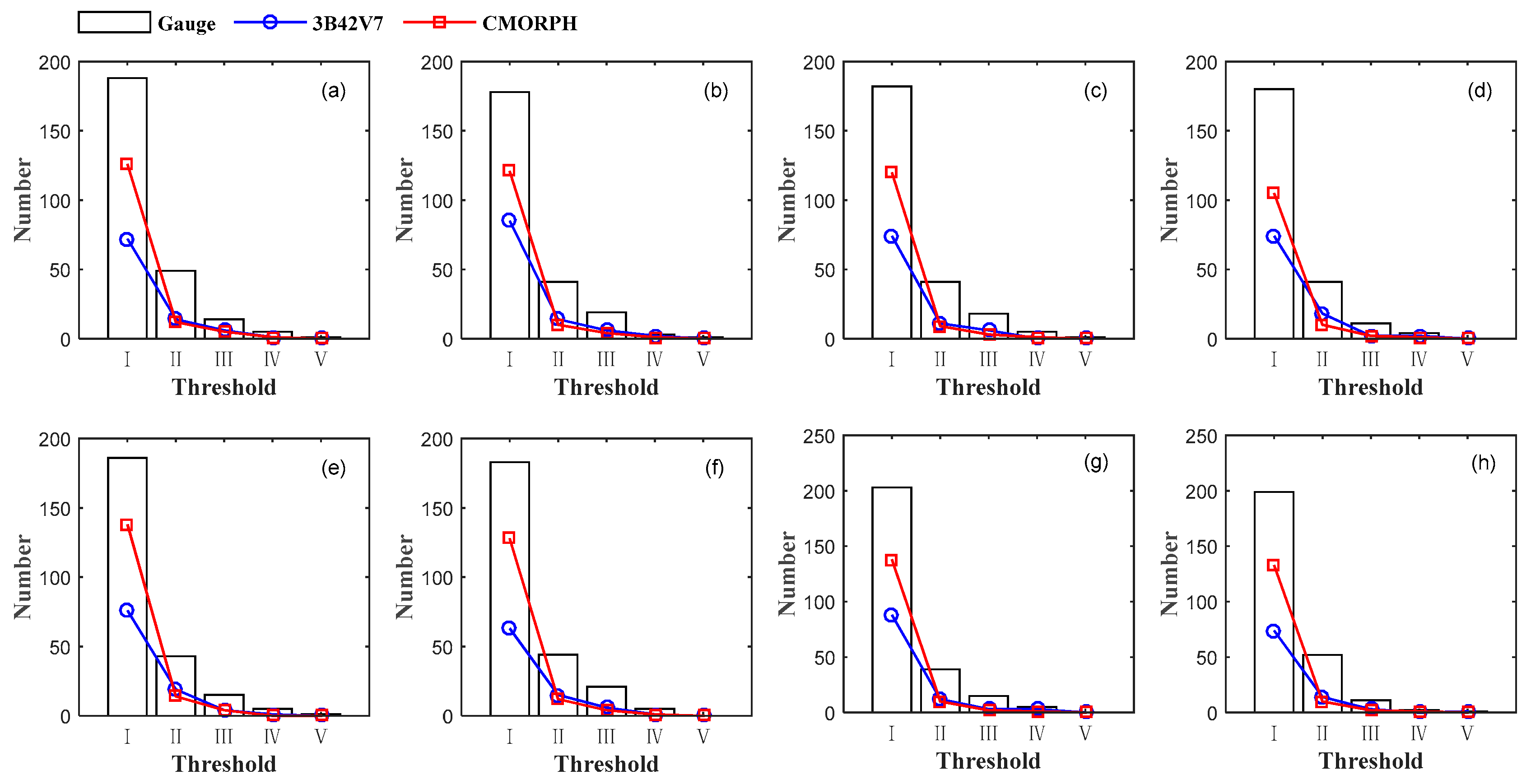
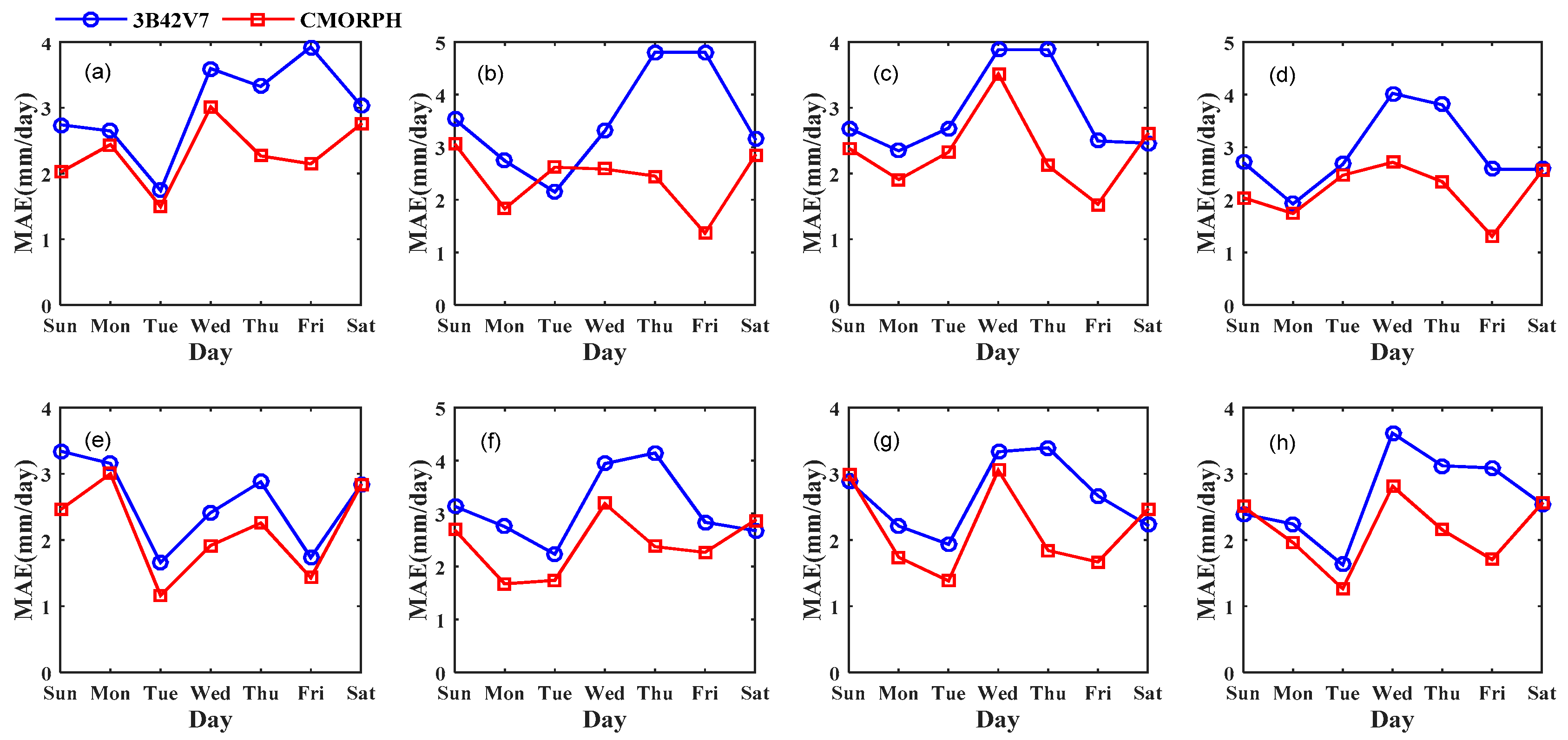
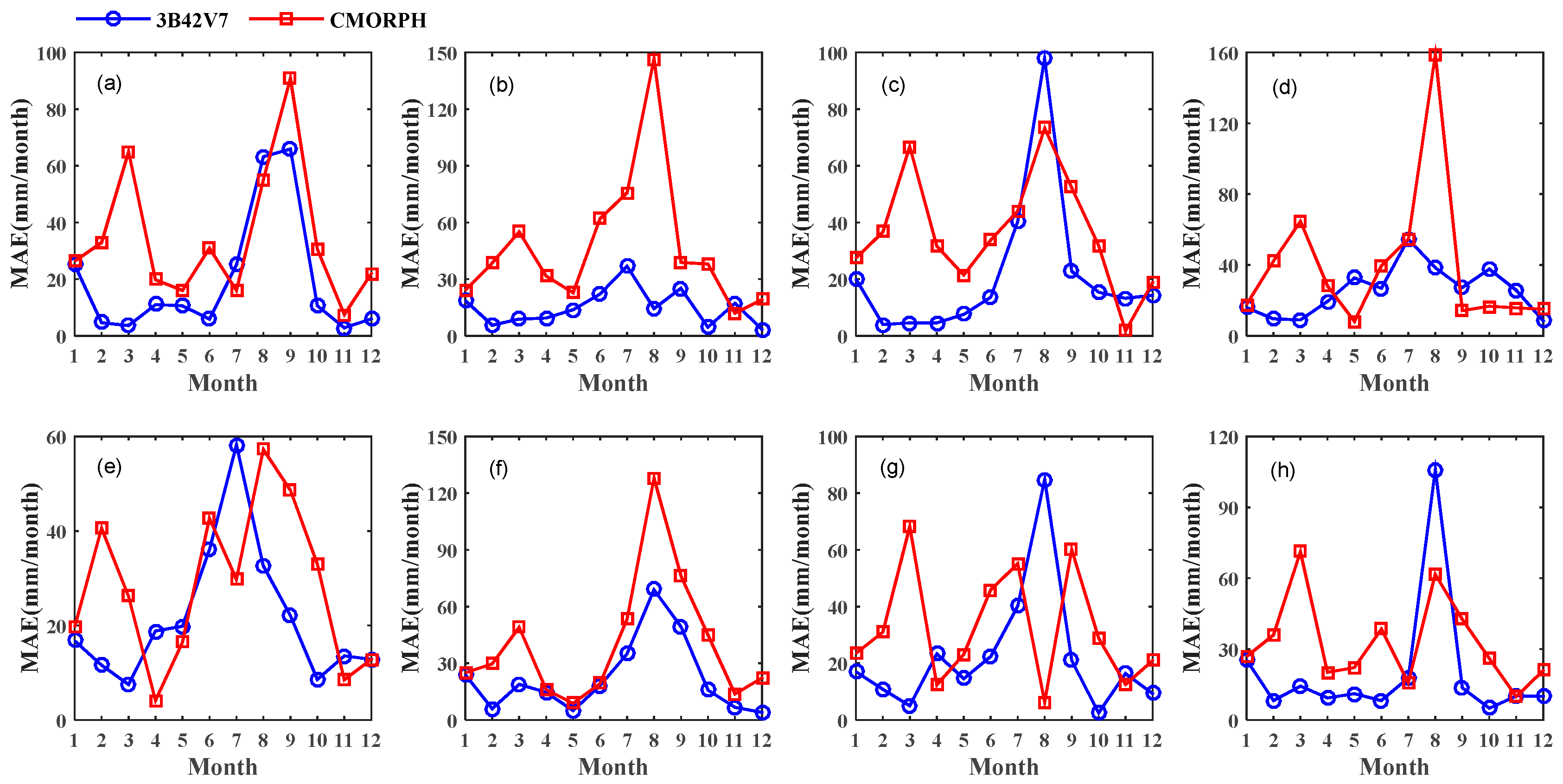

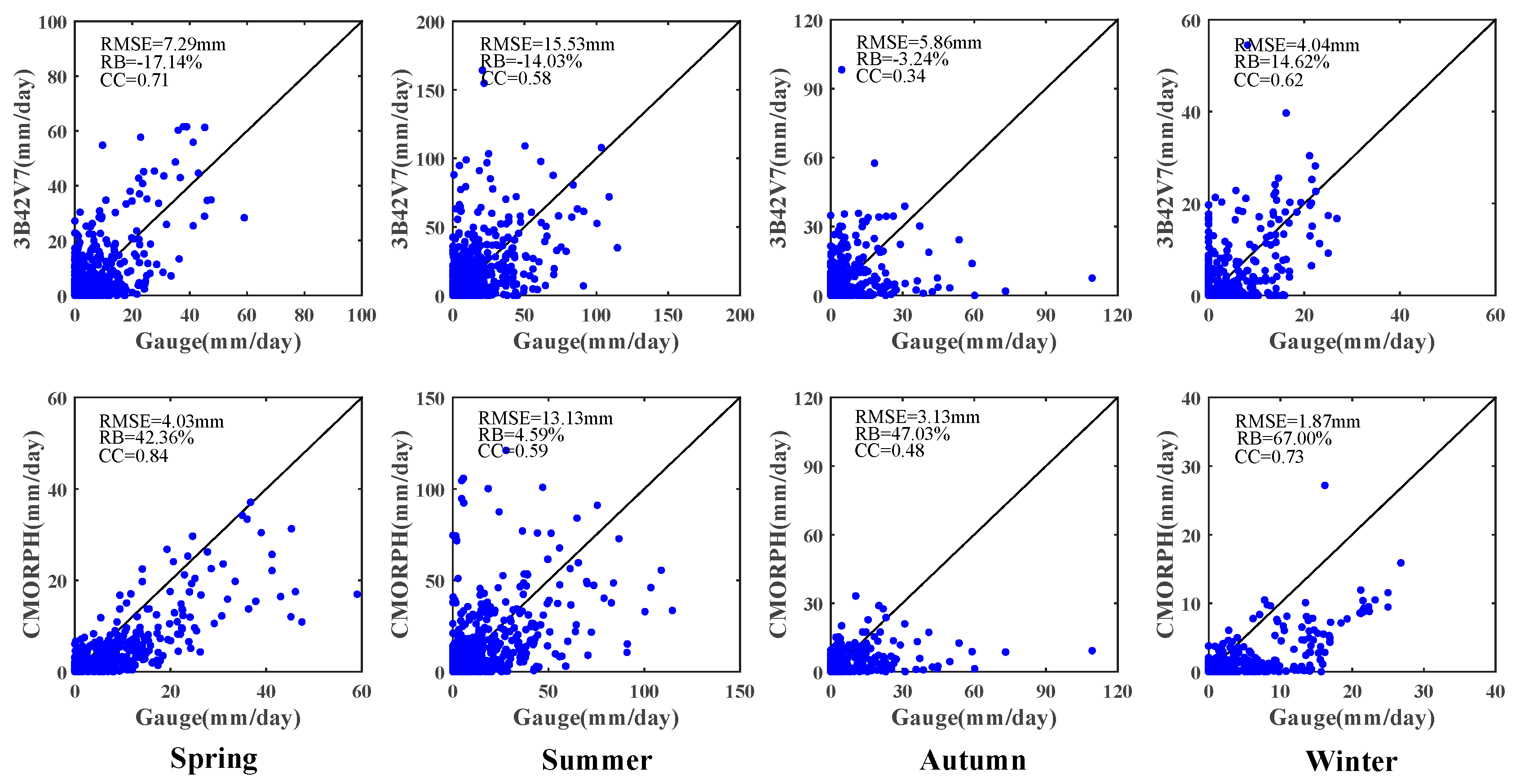
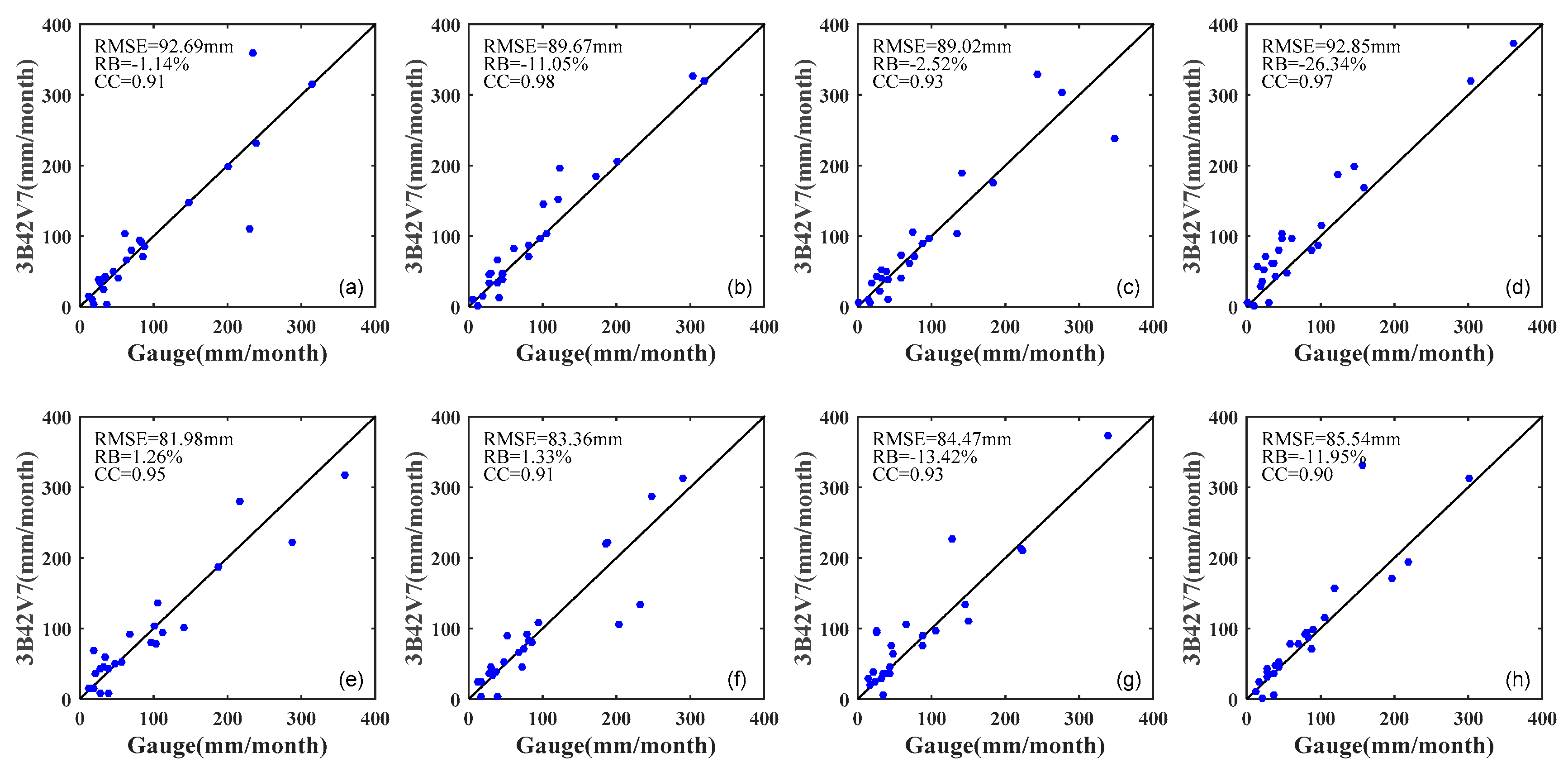

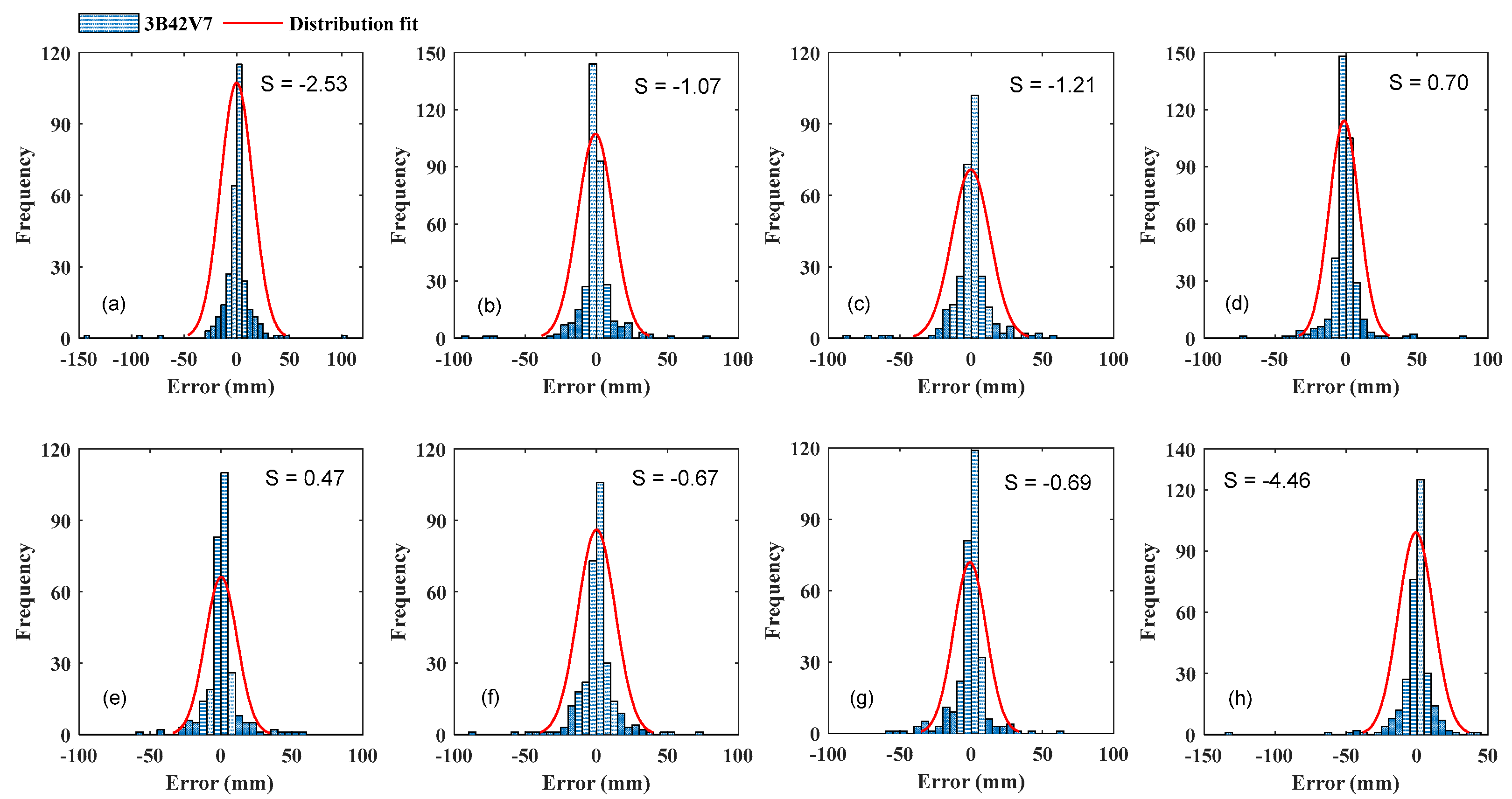
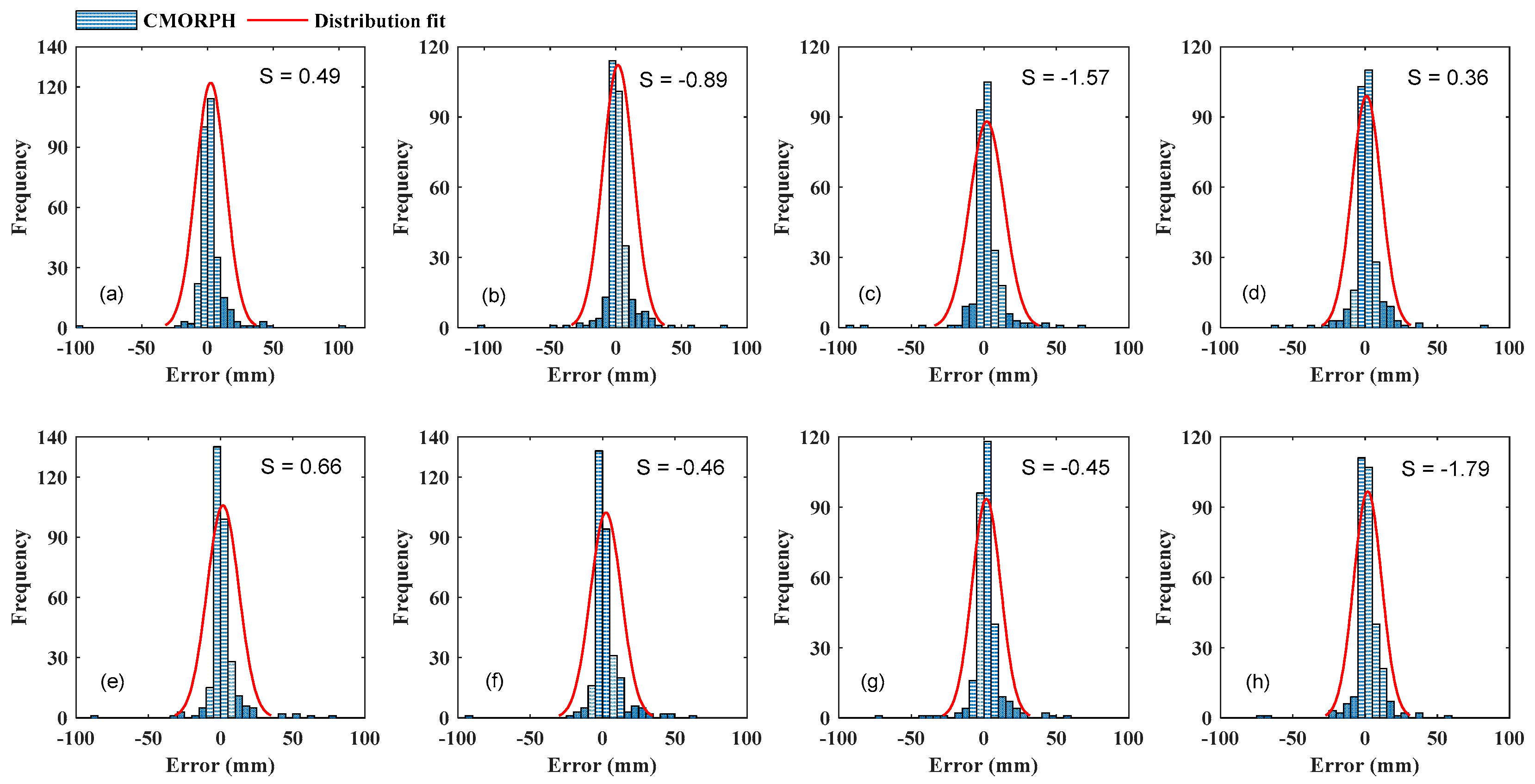
| ID | Gauge Number | Name | Row Number | Column Number | ||
|---|---|---|---|---|---|---|
| 3B42V7 | CMORPH | 3B42V7 | CMORPH | |||
| a | 58361 | Minhang | 76 | 116 | 1206 | 486 |
| 58367 | Xujiahui | |||||
| b | 58362 | Baoshan | 75 | 115 | 1206 | 486 |
| c | 58365 | Jiading | 75 | 115 | 1205 | 485 |
| d | 58366 | Chongming | 74 | 114 | 1206 | 486 |
| e | 58369 | Nanhui | 76 | 116 | 1208 | 488 |
| f | 58370 | Pudong | 76 | 116 | 1207 | 487 |
| g | 58460 | Jinshan | 77 | 117 | 1206 | 486 |
| 58463 | Fengxian | |||||
| h | 58461 | Qingpu | 76 | 116 | 1205 | 485 |
| 58462 | Songjiang | |||||
| Categorical Statistics | Calculation Formula | Optimal Value [0,1] |
|---|---|---|
| POD | 1 | |
| FAR | 0 | |
| CSI | 1 |
| Statistical Indicators | Equation | Indicator Meaning | Unit |
|---|---|---|---|
| MAE | Mean absolute Error | mm | |
| RMSE | Data accuracy | mm | |
| RB | Degree of Deviation | % | |
| CC | Degree of Relevance | Unitless |
| Date | Rain Gauge | 3B42V7 | CMORPH | ||||
|---|---|---|---|---|---|---|---|
| Numbers | Total Extreme Rainfall (mm) | Grids | Total Extreme Rainfall (mm) | Grids | Total Extreme Rainfall (mm) | ||
| 2010 | 3 March | 1 | 59.00 | / | / | / | / |
| 29 June | 1 | 61.70 | 1 | 53.08 | / | / | |
| 4 July | 6 | 383.50 | 1 | 50.40 | 4 | 310.46 | |
| 5 July | 3 | 206.05 | 2 | 121.87 | / | / | |
| 12 July | 1 | 53.60 | / | / | / | / | |
| 17 August | 1 | 55.80 | / | / | 1 | 67.72 | |
| 18 August | 1 | 86.80 | 1 | 63.11 | 1 | 72.77 | |
| 26 August | 1 | 64.50 | / | / | / | / | |
| 27 August | 1 | 64.10 | / | / | / | / | |
| 30 August | 1 | 70.60 | / | / | / | / | |
| 1 September | 3 | 242.60 | / | / | / | / | |
| 13 September | 1 | 53.65 | / | / | / | / | |
| 23 October | 1 | 59.10 | / | / | / | / | |
| 2011 | 10 June | 1 | 69.90 | 1 | 87.60 | / | / |
| 17 June | 2 | 112.80 | / | / | / | / | |
| 18 June | 8 | 747.05 | 6 | 427.98 | 1 | 55.53 | |
| 14 July | 1 | 59.00 | / | / | / | / | |
| 12 August | 2 | 111.60 | 2 | 206.77 | 1 | 56.43 | |
| 13 August | 1 | 91.00 | / | / | / | / | |
| 17 August | 1 | 72.40 | / | / | / | / | |
| 25 August | 1 | 50.70 | / | / | / | / | |
| Total | 39 | 2775.45 | 14 | 1010.81 | 8 | 562.91 | |
© 2018 by the authors. Licensee MDPI, Basel, Switzerland. This article is an open access article distributed under the terms and conditions of the Creative Commons Attribution (CC BY) license (http://creativecommons.org/licenses/by/4.0/).
Share and Cite
Jiang, Q.; Li, W.; Wen, J.; Qiu, C.; Sun, W.; Fang, Q.; Xu, M.; Tan, J. Accuracy Evaluation of Two High-Resolution Satellite-Based Rainfall Products: TRMM 3B42V7 and CMORPH in Shanghai. Water 2018, 10, 40. https://doi.org/10.3390/w10010040
Jiang Q, Li W, Wen J, Qiu C, Sun W, Fang Q, Xu M, Tan J. Accuracy Evaluation of Two High-Resolution Satellite-Based Rainfall Products: TRMM 3B42V7 and CMORPH in Shanghai. Water. 2018; 10(1):40. https://doi.org/10.3390/w10010040
Chicago/Turabian StyleJiang, Qin, Weiyue Li, Jiahong Wen, Can Qiu, Weiwei Sun, Qilin Fang, Ming Xu, and Jianguo Tan. 2018. "Accuracy Evaluation of Two High-Resolution Satellite-Based Rainfall Products: TRMM 3B42V7 and CMORPH in Shanghai" Water 10, no. 1: 40. https://doi.org/10.3390/w10010040






